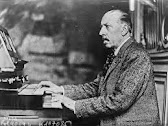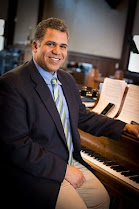Passacaglia and Fugue BWV 582, J.S Bach
When Fr Gerry asked me to play for his farewell service, one of his requests was that the prelude be about 20 minutes long. As soon as he had asked of that, the first piece I considered was Bach’s Passacaglia and Fugue in C minor, and for good reason!
This work of Bach consists of 20 variations!! Albert Schweitzer advised that "Each of the twenty sections ... must have its own characteristic tone colour (but) ... no colour must be sharply differentiated from its predecessor or its successor." The work opens with a stately eight-bar theme followed by the 20 variations and an overwhelming tutti. The double fugue is built on the first part of the passacaglia theme in combination with a countertheme in eighth notes. The work closes with a massive climax of suspended harmonies and full instrumental sonority.
Although this work has 20 variations, I thought it seemed necessary to add in representation to the 17 years Fr Gerry has been at Trinity, with each year he had served here having something unique to them and intensifying each year. And with the excitement and triumph of the last variation representing his last year spent here at Trinity before going out with great exultation.
Love, M. Balog
Several years ago, Kay Sevick approached me about commissioning someone to compose an anthem for the occasion of Fr. Gerry’s 30
th Anniversary to the priesthood. She wanted to use his favorite George Herbert text, “Love Bade Me Welcome” from a collection of poems written in 1633. After discussing who could write it and the commission involved, we both agreed that I would write it! The song, written originally for solo voice, consists of 3 verses, the first two verses ending with Love (God) questioning the listener. These verses end on a dominant chord, leaving the listening waiting for the answer. The final verse ends on a Major Tonic chord, as in answer, Love invites us all to the table. Micki and Alyssa premiered this piece, 2017(?), and will offer it together at this service.
Lacrimosa, W.A.Mozart (From Requiem)
One of the requests Fr Gerry had asked me to play for him is an arrangement for solo organ on Mozarts Lacrimosa (from Requiem). This was requested by him shortly after I started my position here at Trinity as Organist. Mozart composed part of the Requiem in late 1791, but it was unfinished by the time of his death on December 5th of that same year, We do know that Mozart did compose the first 8 bars of the Lacrimosa, one of the most beautiful movements of the Requiem. Lacrimosa translates to “Full of tears”, and the beauty of the music written shortly before Mozart’s own death brings to mind all of the emotions that a person can feel as they examine the joys and sorrows of their own life. The piece culminates in a crescendo to a final “Amen”. This will be the last prelude offered before the service.
I Can Only Imagine, Bart Millard
“I Can Only Imagine” was originally recorded in 1999 by the Christan band, Mercy Me. Written by lead singer Bart Millard, it imagines what it would be like to be in front of God in heaven. Released in 2002, it received Dove Awards for song of the Year and Songwriter of the Year. It is the most-played song in the history of Christan radio, as well as the best-selling Christian song of all time. I asked Fr. Gerry his thoughts on the song, and he explained that it brings to mind not only the times in the service that we want to raise our hands in praise, but also to kneel in reverence. On Saturday Alan will bless us with his singing of this song.
I Believe, Mark Miller
When Fr. Gerry and I pondered an anthem for this service, of course my mind went straight to “I Believe”, by Mark Miller. The first time I heard this anthem at a conference, I went immediately to the vendor booth and purchased their remaining copies. When I introduced it to the choir, it became a favorite. It was the first anthem that we recorded during Covid. The text is linked to writings found in a cellar where Jewish families hid during the Holocaust. “I believe in the sun, even when it is not shining," is a powerful phrase often used as a poem, signifying unwavering hope and faith, even amidst darkness. The music begins simply, with a solo voice. As the music swells and grows with additional voices, we sing about love. Finally, we return to the solo voice, and sing “I believe in God, even when God is silent”. Alyssa will be our soloist.
Rubrics- “The Peace Be Exchanged” Dan Locklair
This is the other organ compostion Fr Gerry had asked requested for his service of leaving (along with the Lacrimosa). You will be hearing this during communion. The first time he heard this piece was during the organ installation concert here at Trinity, which was played by guest organist, Joseph Painter. Commissioned in 1988 for the Organ Artists Series of Pittsburgh,
Rubrics has quickly become a staple in the American organ repertoire. Each of its five movements is based upon the rubrics (liturgical instructions) present in
The Book of Common Prayer. “The Peace may be exchanged”
is the fourth movement in the suite, and its text is taken from a brief rite entitled “A Thanksgiving for the Birth or Adoption of a Child.” In this striking beautiful aria, Locklair utilizes simple rhythmic and melodic motives to great effect, using dense writing in the manuals and double pedal to create a sonic tapestry that is subtle and moving.
Finale - Organ Sonata No. 1, Alexandre Guilmant
For the postlude of this service, I decided on Alexandre Guilmants third movement
“Finale”, from his Sonata No. 1. I couldn’t think of anything more fitting for Fr Gerry’s 17 years of service here at Trinity, and over 30 years all together as priest.
To me, this work expresses much of the emotion and challenges a rector could experience, as well as the uplifting and inspiring supernatural moments created working as a servant of the Holy Spirit and disciple of God. The frenetic Finale in D minor speeds along in an ABA-coda form, with the A sections almost entirely blanketed in running 16th notes, with the small finger of the right hand in charge of presenting a forceful tune by stretching and phrasing it all together. This momentum suddenly stops so that a solemn chorale can be heard in the B section, consisting of mostly half notes with a pedal flourish at the end of each phrase. The piece culminates in an overpoweringly visceral Maestoso as coda.
All of the hymns selected are Fr. Gerry’s favorites:
I Bind Unto Myself Today
The Servant Song
Now My Tongue the Mystery Telling
Let All Mortal Flesh Keep Silence
Be Thou My Vision
King of Glory, King Of Peace
I Want to Walk As a Child of the Light





















